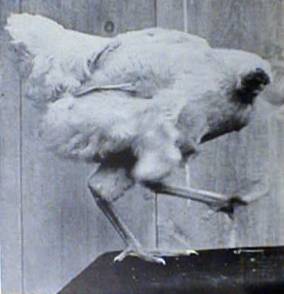Mike the Headless Chicken
Toss the phrase “running around like a chicken with its head cut off” (without quotes) into Google and you’ll get about three million citations. It, colloquially, means to run around in a manic, frenzied manner, perhaps because a chicken that has recently lost its head may actually do something similar before finally dying. Whether that actually happens — to recently decapitated chickens, that is — isn’t all that interesting, as even recently-deceased humans often still move. A study published in early 2000, for example, found that 39 percent of brain-dead people made noticeable movements — “spinal reflexes that do not involve any brain activity” — so it should be possible for headless chickens to do the same thing, at least for a few minutes. But it shouldn’t be possible for headless chickens to live, head detached, for 18 months. That just can’t happen.
Except for the time that it did. Meet Mike the Headless Chicken.

That’s him, above. 100% chicken. 0% head. LIFE magazine has few better photos, like this one with his head lying next to his feet, fully disconnected from the rest of his body. It’s real, too.
What happened? In 1945, Mike the Headless Chicken — before he was headless — was owned by a farmer named Lloyd Olsen of Fruita, Colorado. Olsen and family wanted a chicken dinner one evening, so someone in the household — it’s unclear who — went back to the coop, axe in hand, to find and slaughter one. It was a swing and a hit — mostly. As Cecil Adams of Straight Dope summarizes, only about two-thirds of the chicken’s head came off. The axe “sheared off the frontal lobes, rendering the bird totally incapable of thinking about Immanuel Kant but leaving enough of the brain stem to take care of breathing, blood circulation, and the like.” According to LIFE, Mike got up from the chopping block, head on the ground, and “soon began to strut around.” Mike the Chicken was alive, but he had literally lost his head.
For the rest of Mike’s life, the Olsens toured the country with their prized possession. They fed him through his esophagus, with a diet primarily consisting of a milk mixture (via an eyedropper, as seen here) and with small grains of corn. The Olsens made a small fortune by charging 25 cents to view this freakish miracle. According to Wikipedia, Mike brought in about $4,500 (nearly $50,000 in today’s dollars) at the peak of his fame. He was valued at $10,000 (well over $110,000 accounting for inflation), making him likely the most valuable chicken in the world. Efforts to replicate the phenomenon — and there were such efforts, of course — failed. Mike was one of a kind.
His uniqueness may have also played an active role in his death. In March of 1947, while on tour, Mike started choking on his food — and the Olsens didn’t have their special feeding tools on them. They were unable to save the choking headless chicken, and according to the bird’s official website (because every headless chicken needs a website), Mike died, 18 months after he probably should have.
Bonus Fact: Buzkashi is the name of a common pastime in Afghanistan. It’s a game very similar to polo — it’s played on horseback as riders strive to hit an object into a goal. But unlike polo players, those engaged in buzkashi aren’t hitting a ball. They’re striking a headless goat carcass.
From the Archives: Seeing Red in the Hen House: Why some chickens used to be outfitted with red glasses.
Related: “Caution: Area Patrolled by Attack Chicken.”
